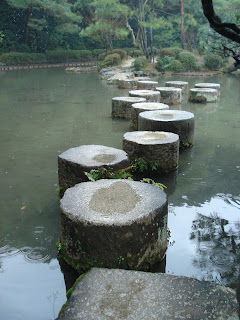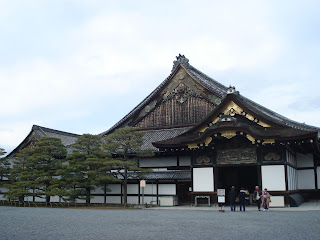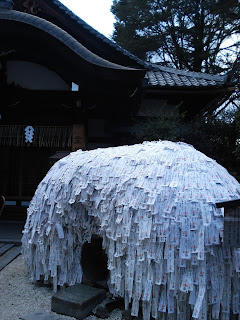Imperial capital of Japan from AD 794 to AD 1868, preserved from the bombs that flattened the rest of the country during WWII and home to 17 UNESCO World Heritage Sites, Kyoto is the place to go in order to immerse oneself in 'Traditional Japanese Culture'. I never thought I'd say this, but there is almost too much to see!
 |
| The exterior of an unnamed temple backing on to the 2km Tetsugaku-no-Michi (Path of Philosophy) in northwest of the Higashiyama area. |
Surrounded by the natural beauty of many lush mountains (and number of the smaller ones of which have been incorporated into the city, disturbing the otherwise strictly grid-like layout of the streets) and filled nearly to brimming with ancient and newer shrines (Shinto), temples (Buddhist), palaces and parks, not even the rain that I encountered on my first day there could spoil the beauty that is Kyoto - in fact, I think it may have just enhanced it. If anything, my only complaint (alongside that I did not have nearly enough time there to just sit down and appreciate everything) is that many of the temples, palaces and parks (as well as the odd shrine) charge quite a bit for entry (usually around 500 or 600yen - 6 or 7USD ) and, while they are visually stunning and definitely worth it, a pre-paid tourist card or combination ticket granting entry to a number of the sites for an amalgamated fee might make some sense to implement.
 |
| The grounds of Heian-jingu just north of Higashiyama station. The massive Shinto shrine complex was built in 1895 to celebrate Kyoto's 1100th anniversary.. |
 |
| The Chinese-style bridge in the western part of Heian-jingu's gardens. Although I had to pay to get in to them, I think it was more than worth it - even on a rainy winter's day. |
 |
| Stepping stones leading across one of the ponds at Heian-jingu. My favourite part? Not only are you allowed to cross on them, you are expected to. |
With Kyoto Station and the much more modern downtown Kyoto located somewhat in the centre, the city can be divided into two main sightseeing areas, Higashiyama in the East and the quieter Arashiyama are in the West. This having been said, there is also quite a bit to see in the centre, as one of my favourite temples, Nishi Hogan-ji (free and open 6am-4:30pm), was located just northwest of the station. Also in the centre, though quite a ways North from there is the beautifully gilded Nijo Castle with its exquisitely painted interior (600yen, 8:45am-5pm, no pictures allowed but oh so worth it) and, a even further north of there, Kinkaku-ji with it's ever-famous Golden Pavilion (no, really! First constructed in 1397, the present structure was built in 1955 after an overzealous monk burnt down the original five years previous). Other things to see in the city centre include the lively shopping street extending westward from Yasaka Shrine as well as the Nishiki Food Market just north of there. The Nishijin Textile Centre (free, open 9am-5pm) to the north of Nijo is also worth a visit for anyone interested in traditional Japanese dress. The centre puts on several free Kimono fashion shows per day, contains a small textile museum, provides weaving demonstrations and, of course, has a display and sale area for their products. I don't recommend visiting the Kyoto Imperial Palace, it's closed to the public and, while the grounds are extensive, there is really nothing there. As a note, many of the places I just mentioned are not within walking distance. Trust me, I walked. I recommend either buying a day pass for the bus (around 600yen) or borrowing a bike for the day.
 |
| One of the world's largest wooden structures, the gilded main hall of Nishi Hogan-ji made it one of my favourite temples in the city. Sadly, despite it's proximity to the station and lack of entry fee, both it and equally splendid, equally free and nearby Higashi Hogan-ji seem to get left off many tourist itineraries. |
 |
| Ninomaru Palace in Nijo-jo, or Nijo castle. Built in 1603 by Shogun Ieyasu Tokugawa, first of the Tokugawa Shoguns, The exterior of the building may not look like much, but I would rank it among the top places to visit in Kyoto. The painted screens and ceilings inside are breathtakingly lovely (with many painted in gold) and the 'nightengale flooring' designed to squeak as you walk (even in your borrowed slippers) so as to warn off intruders, makes the experience even more interesting. |
 |
| Kinkaku-ji's famous Golden Pavilion - originally built in 1397 as a retirement villa by Shogun Ashikaga Yoshimitsu, it was turned into a temple by his son as per his wishes upon his death. This is the 1955 reconstruction. |
I was fortunate enough to be based in the Higashiyama area just to the East of the centre - most of the sites of which are within walking distance of one another - though if you plan to cover the whole area, be warned that it is a very long day. I was even more fortunate in that I managed to find an old traditional-style house - complete with tatami floors, futons, a supremely narrow staircase, an outdoor bathroom in the courtyard and old-style shoes to wear to get out there - in which to stay (for all those interested, check out Hostel Haruya, Higashiyama branch - the staff were wonderful). While I definitely recommend checking out some of the main sites in the area, I also recommend just wondering - I found a number of my favourite places that way.
 |
| The raked gardens of Ginkaku-ji, also known as the Silver Pavilion - although it was never covered in silver. A fairly popular site, it was nearly impossible to capture a picture without people in it. The alternating bands of gravel in the front are said to represent the waves on the lake or sea, and the cone in the background the stillness of Mount Fuji by contrast. |
 |
| The delightful cemetery and pagoda atop a hill at Kurodani Temple. This area was so peaceful, and the view of Kyoto from the top of the hill so nice that i could have happily stayed there all day. As an aside, any traveller to Kyoto can't help but notice that many of the temples in the area are surrounded by cemeteries - in complete contrast to the areas surrounding Shinto shrines. A quick question to one of the English speaking monks I encountered garnered me the answer that the dead are considered as sources of impurity (in the sense of cleanliness) in Shinto and that purity is important when approaching the Kami spirits for help or advice. |
 |
| The beautiful moss-covered gate at the stunningly dilapidated Honen-in. Established in 1680 , this extremely quiet temple was stumbled upon as I was wandering off the Path of Philosophy. |
 |
| The garden and Japanese style water-chain at Reikan-ji - another of the temples that I accidentally stumbled upon while ranging of the established Path. |
 |
| Some of the painted screens on display at Reikan-ji. Although these are lovely, they are nothing in comparison to those in Ninomaru Palace. |
 |
| A traditional Japanese water drainage system, ensuring that temple roofs are not overwhelmed by the rain. |
 |
| Yoshida-jinja. Located on a small mountainous hill in the northern Higashiyama area, I stumbles across this one when I saw a red torii (Shinto gate) on a path leading to a wooded area while wondering lost in the back streets of Kyoto - streets which themselves are quite fascinating as they are filled with old-style houses. |
 |
| Yasui Kompiragu, another of the shrines I stumbled across, this one located at the south end of the Gion district, northwest of Kiyomizu-dera. Hidden in the backstreets and announced only by stone torii opening on to the road, when I first wandered up to the temple I was greeted by the sight of people in full business attire bowing, crawling through the hole, bowing once more and coming back through before pinning their prayers onto the rock. Interestingly, when asked why this was done I could get no straight answer, seems the sanctuary is linked to everything from traffic to health to riches and marriage. Research on the net in English seems to suggest that passing through once should bring about a good relationship, and twice a good divorce. Research in french on the other hand, links the shrine, supposedly established in 656, back to health and the curing of epidemics. I'm hoping someone who speaks Japanese will eventually be able to clear this up for me! |
One of my absolute favourite sites, and one I definitely suggest checking out is Yasaka Shrine in central Higashiyama. It's always free and always open, borders on Maruyama Park, is beautiful both night and day and always seems to have a steady stream of people passing through to throw a coin, ring the bell and provide the ritual two bows and two claps to cement their requests - be warned that if you also plan to ask something of the kami being worshiped, you should probably make sure that you purify yourself first. This involves first washing the left, then the right hand, and then rinsing your mouth. There are always nicely decorated basins with running water at which to do this - just don't make my mistake and poor your used water in with the clean! Another of my favourites was Kiyomizu-dera, or Kiyomizu Temple. Built into the side of a mountain a kilometer or so south of Yasaka Shrine, there is a reason this is one of the UNESCO sites (and only 300yen as well!). Just to the left of the Kiyumizu-dera entrance lies Tainai-meguri which offers possibly one of the coolest experiences in Kyoto as you descend into a pitch black cave to be reborn (100yen suggested donation, try to go down when you can be alone). The area between Yasaka Shrine and Kiyumizu-dera is also worth a wander - if not more than one. Filled with narrow lanes and shop sellers offering up a taste of their treats, it's here that you are most likely to encounter those who have paid to be dressed as geisha for the day.
 |
| Two lovely shop ladies up near Ginkaku-ji offering up sweet samples. |
 |
| Red bean, chocolate, strawberry and who-knows-what-else filled rice pastries. I was given so many of these to try while wondering along the shop filled streets that I was nearly dizzy from sugar consumption. My favourite remain the red bean - although read bean and green tea are also quite tasty. |
 |
| A tourist made up as a Geisha poses for me in the streets around Kodai-ji. |
 |
| And another, this one in the tiny, but enchanting Yasaka Koshin-do Temple. If you look to the left, you may notice what look to be small coloured balls hanging behind her. In fact, they are small plush Kukurizaru, or hanging monkeys, who are folded in half with their hands and feet tied behind their backs as a reminder to those making a wish that in order for it to be fulfilled, they must control their temptations and desires. |
 |
| Wandering the streets leading to Kiyomizu-dera. |
 |
| The sky opening to shine down on Kiyomizu-dera, with it's view of Kyoto in the background. |
 |
| Looking back toward the pavilion at the entrance. |
 |
| The entrance to Jishu Shrine. Although this Shrine is located on the grounds of Kiyomizu Temple, it is not technically affiliated. This combination of shrine and temple is not actually all that uncommon in Japan, with traditional Shinto and introduced Buddhism having a long and intertwining history in the country - particularly after Toyotomi Hideyoshi brought the two closer together in an attempt to block Christianity from gaining ground in the 16th century. Interestingly, syncretism of the two religions was declared illegal during the Meiji Restoration of the 19th century (when the Emperor was nominally returned to power after centuries of rule by the shoguns) so that state Shinto could be used to reinforce to order of society. |
 |
| A woman prays at the main shrine in Jishu-jinja . Jishu is a popular destination for those seeking luck and love. I loved the way the riotousness of the shrine contrasted with the staid tranquility of the temple surrounding it. |
 |
| Two stones of which it is said that, if you can walk from one two the other with your eyes closed on the first try, your true love is sure to be soon revealed. At the far end you can see a group of teal-clad Taiwanese students helping (and in some rather amusing cases, hindering) each other's crossings. |
Located even further south of here (take the train or subway) is Fushima-Inari Taisha, a breathtaking temple complex dedicated to Inari, goddess of the rice harvest (and thereby sake and business as well). Established in the 8th century, the most fascinating aspect of the complex are its 4km of mesmerising mountain pathways winding under seemingly endless amounts of bright red (though some might call it orange) torii (Shinto shrine gates).
 |
| A stone fox, messenger for Inari, guards one of the gates at Fushima-Inari Taisha. |
 |
| Beginning my wander through the never-ending red torii. |
As for the Arashiyama region to the Northwest of Kyoto, while it must be lovely during the summer, located as it is on a floodplain surrounded by mountains, and preserved as an escape without many tall buildings, I'm sure it must be absolutely lovely in summer. In truth, by the time I made it out to Arashiyama, I was nearly completely templed-and-shrined-out. My chief goal in heading there was actually to pay a visit to the Iwatayama Monkey park. Located a-top a fairly steep though not overly tall hill, the park allows visitors to not only get close to Japanese macaques that are native to the area, but provides a beautiful view of the city as well.
 |
| We passed these two en route up. The keeper told us that they were two of the most friendly. Left to their own devices, the hundreds of monkeys on the mountain are surprisingly nonchalant about having people invade their home - provided of course that you don't go about provoking them. |
 |
| Although it may not look it. It is actually I, and not this adorable little dude, who am in the cage. In order to allow visitors to safely feed the monkeys, they (both visitors and monkeys) have all been trained to understand that snacks are only given by caged people to free monkeys, and not under any other circumstances. |
 |
| Looking out toward Kyoto from my people-cage. After sufficient time spent feeding them, I want out to wander amongst them. They were just fascinating to watch. Sadly (or fortunately?), they did not seem to be anywhere near that interested in me. |






























1 comment:
It all looks very peaceful. Lovely place.
Post a Comment